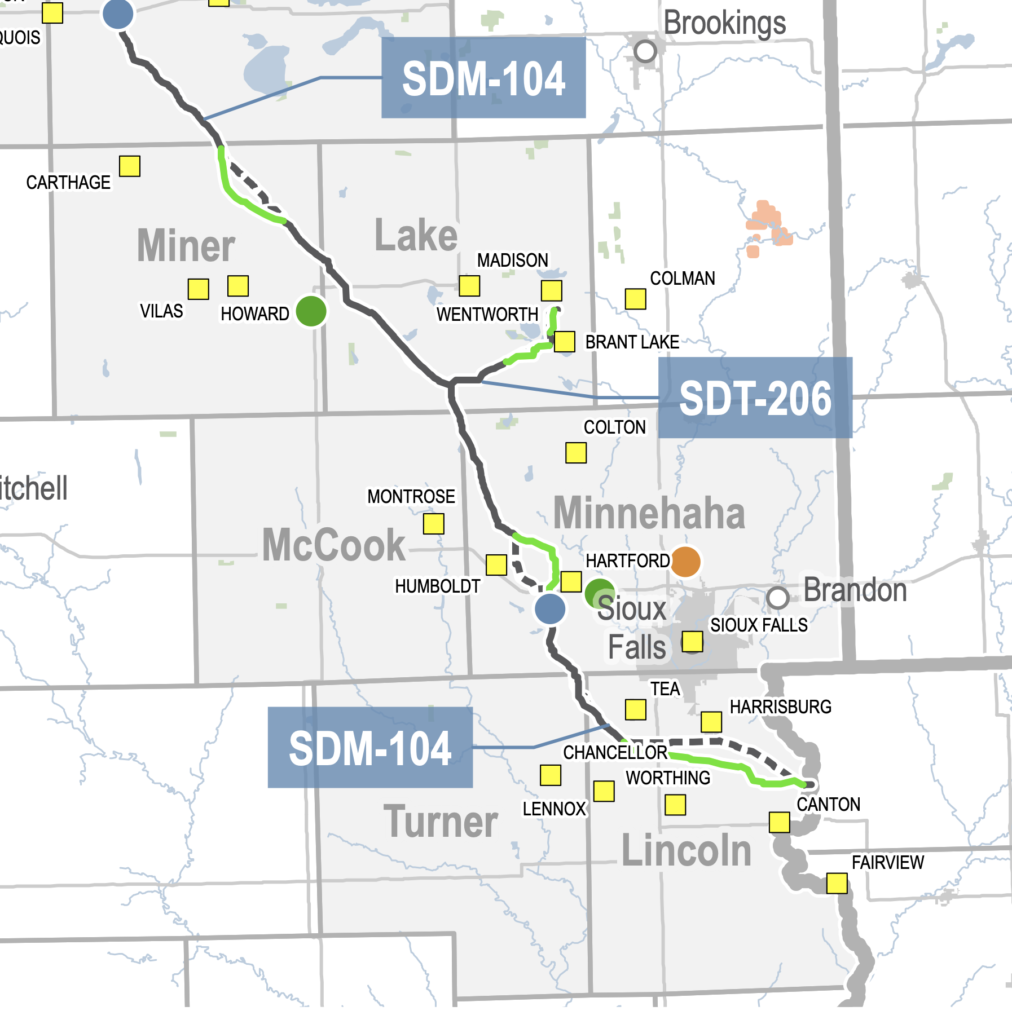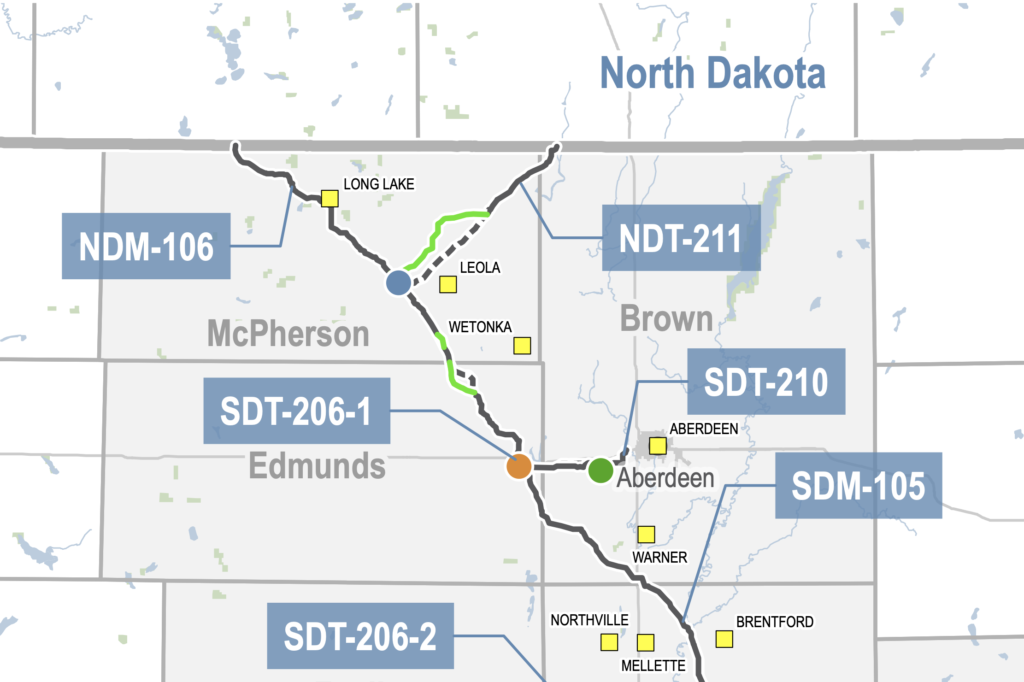Last updated on 2022-04-16
A relatively new law allowing the Public Utilities Commission to limit who can intervene in its permitting process for the Summit Carbon Solutions carbon dioxide pipeline through East River did not stop the PUC from opening the process to hundreds of interested parties. Bob Mercer reports that PUC yesterday granted party status to over 300 applicants yesterday. The intervenors include individual landowners, Hutterite colonies, cities, counties, rural water systems, ethanol producers, the Methodists, and the West Central School District. The PUC gave another 30 applicants two more weeks to provide information supporting their requests to intervene.
I don’t see any conservation, labor, or land-rights groups among the accepted intervenors. Activist groups on hold include the Great Plains Laborers District Council, the Great Plains Action Society, and the International Union of Operating Engineers Local 49. Their exclusion comes because of the 2019 law that removed non-profits representing community interests from parties allowed to intervene in PUC dockets.
Even without public interest groups, over 300 parties is a lot of intervenors:
Chairman Chris Nelson said the number of applications for intervention was “unprecedented” in the 11 years he’s served on the commission.
SCS Carbon Transport filed the original application February 7, 2022. A hearing date hasn’t been scheduled. State law says the commission has one year to reach a decision unless the applicant seeks an extension.
Commissioners Gary Hanson and Josh Haeder said they would consider reopening the intervention period if any additional people or businesses could be affected by the company’s changes to its proposed route [Bob Mercer, “Hundreds in S.D. Get to Intervene on CO2 Project,” KELO-TV, 2022.04.14].
According to this April 12 staff response to applications for party status, the PUC received over 370 applications for party status. Using the standards in SDCL 49-41B-17 amended in 2019 and discussed in the PUC staff’s March 17 memo, the PUC defined the “directly interested persons” entitled to intervene as anybody with an address within ten miles of the proposed pipeline route. If applicants live more than ten miles from the proposed pipeline, staff considered whether the applicants own land, work, “or otherwise physically frequent” areas near the project or “claim a business interest that would be directly impacted by the project.” The 30 individuals and entities from whom the PUC is requesting more information did not meet those criteria, but the PUC is still giving those applicants two weeks to argue otherwise.
As I expected, the PUC granted intervenor status to Hartford real estate developer William G. Haugen, Jr., but put Eagle Butte anti-pipeline activist Joye Braun on the need-more-info list. Haugen claims business interests along the route; Braun lives 62 miles away and claimed interest in broad environmental harms and fossil-fuel dependence.
Commissioners Hanson and Haeder’s openness to reopening the intervention period is a good idea. Last week, on April 8, the day that was the deadline to apply for intervenor status, Summit Carbon Solutions submitted a new route map showing some significant detours:


The new route bends further south to stay farther from Harrisburg. It bends east to go closer to Hartford instead of Humboldt. It takes a longer bulge west in northeastern Miner County, maybe leaning a bit away from wetter ground. The route jukes west instead of east near the Edmunds–McPherson border. And the spur from North Dakota leans north to run farther from Leola. This high-level map doesn’t explain why those changes are made or where exactly they happen, but they surely would move some filed intervenors out of the ten-mile zone and bring others who have not applied in. The PUC should ask for more detailed maps, publish them, and give newly targeted landowners, folks who could face eminent domain at the hands of rich Iowa Republicans and North Dakotan oilmen, a chance to formally intervene and voice their concerns to the PUC.
These stupid PUC Commissioners and the stupid Legislators don’t understand anything about South Dakota’s grassroots people. They spend all their time hobnobbing with the elite, they don’t really get how mad people get when they are made to sit in the corner. Limiting the people who can intervene makes people want to intervene. So now they’ve got 300+ intervenors. Good luck with that.
I would like to hear what benefit this carbon pipeline is to the
climate. I want to know how much carbon is sequestered per year
and what percentage that is of the total carbon that is emitted by
the United States per year. Skeptic and cynic that I admit to be,
I suspect it would be miniscule.
It sounds like the project will make a sizable amount of money
for the backers of the pipeline but is there a long term benefit
to the climate? If someone can either answer these questions
or point me to where I can get some answers, I would
be appreciative.
Eminent domain for thee but not for me.
https://moodycountyenterprise.com/article/a-need-to-be-organized
Good point, Donald! I don’t know how many of those intervenors are members of Sierra Club, Dakota Rural Action, or any other organization, but if they are members, the PUC could have saved themselves a lot of paperwork and complication in the hearings if they had allowed non-profits to retain their standing.
Navigator CO2 does not appear to have filed an application for Heartland Greenway with the PUC yet.
Larry! Thanks for sharing that Moody County Enterprise article. It says the Dakota Rural Action is busy organizing landowners and notes that Nebraska attorney Dave Domina, an expert pipeline/eminent domain lawyer, is helping out.